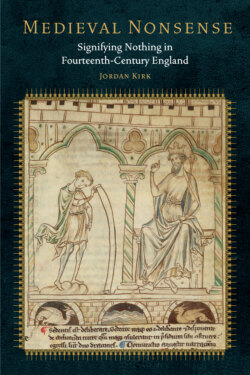Читать книгу Medieval Nonsense - Jordan Kirk - Страница 9
На сайте Литреса книга снята с продажи.
THE WIND IN THE SHELL: PROLEGOMENA TO THE STUDY OF MEDIEVAL NONSIGNIFICATION
ОглавлениеThe theory of signification in the West began as a theory of the oracular.1 The word semeion (sign) first emerged in the realm of divination, as a technical term referring to the enigmas of the mantic utterance.2 The sound that emerges from the mouth of the oracle would seem to signify something; but just what it would signify remains altogether unclear. And likewise—given certain states of mind, or at certain ritually determined times and places, or indeed sub specie aeternitatis—with the sounds of the trees and waters, the configuration of the creases in the palm, or the path a bird takes across the sky.3 A sound, inscription, or gesture seems to point beyond itself—but toward what? When you try to divine something from these appearances, you get nothing more than riddles.
The originary object of linguistic study is thus not what communicates a meaning but what defies all efforts to make sense of it. Indeed, historically speaking it is only belatedly that the category of semeion will come to include signs whose meaning is anything other than obscure. Moreover, the ancient scientists of language were familiar with certain sounds, inscriptions, and gestures that are refractory to interpretation not because they are ambiguous or abstruse but simply because they are devoid of any meaning whatsoever. Neither did they fail to notice that what presents itself in these strange signs, their own mere matter or empty form, is no less present in even the most meaningful signs. For there is a nonsignifying element in every signification, and it is not some extralinguistic substrate on which language would happen to rely but rather what survives, within the scarcely linguistic realm of our various communications, of language itself. In this residue—the bare voice, ductus, or flection—the animal with language, the human being, comes face-to-face with what it is. And yet it is all but impossible to keep the attention there, as anyone who tries it will be able to attest, for when the mind encounters a void of meaning it tends either to turn away from it immediately or, if that strategy fails, to project fabricated significations onto it and then busy itself with them instead of with it. Knowing this, certain technicians of the word have created apparatuses to capture our attention and train it on the meaningless site of all possible meanings.
I began writing this book when, some years ago, I first read the work of a great translator of the fourteenth century, an Englishman who had gathered obscene jokes, character studies, reports of visionary experience, and liturgies of the cult of Love from his own observation as well as from rumors that had reached him from even the most distant lands, and then wove them together into texts that our own speech and writing remain patterned after more than six hundred years later. Scattered throughout the works of the poet whom Virginia Woolf would one day call “the great originator of this still-continuing conversation or argument or song” was a series of words that I could not make any sense of and that no glossary or commentary could help me with.4 For they seemed to be written in an idiom made up only of syllables:
buf
he had written in one place,
rum ram ruf
in another, and
cok cok
in still another; not to mention
cokkow cokkow cokkow
and
kek kek kokkow quek quek
and, perhaps most enigmatically of all,
awak … awak.5
I could not figure out how to read these words, if that is what they are; nor, by the same token, could I figure out how to stop reading them. And so I began to inquire into the question of nonsignification, and in particular into how it might have made itself available for thinking, contemplation, and experiment at the time and place in which this poet, Geoffrey Chaucer, had written them down.
